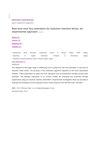Advanced Pitch Angle Control Based on Genetic Algorithm and Particle Swarm Optimisation on FAST Turbine Systems
IF 0.9
4区 工程技术
Q4 ENGINEERING, ELECTRICAL & ELECTRONIC
引用次数: 0
Abstract
In this paper, the increase in the quality of the rotor speed of wind turbines and the decrease in mechanical loads on the turbines are investigated. Adjusting the angle of the blade to the nominal wind speed, the rotor speed of the wind turbine is maintained at its nominal value. Using control methods (such as proportional integral (PI), genetic algorithms (GAs), and particle swarm optimisation (PSO)), different results can be recovered. In addition, individual control of the blade tilt angle allows us to reduce the mechanical loads on the turbine with the control methods. The wind turbine was modelled in Matlab/Simulink. The simulation results show that individual control of the blade tilt angle ensures the quality of the rotor speed of the wind turbine and reduces the balanced periodic loads on the wind turbine. In the first part, we study the wind turbine in a global way, as well as the method used to calculate them. Then, we discuss the FAST system, which was used to model the wind turbine, as well as the design of individual pitch angle control. As a result, it is possible to reduce the fatigue of the mechanical wind turbine parts. According to the study, the mechanical load for all three blades was reduced by an average of 44 % compared to the PI and PSO methods and by 1 % compared to the PI and GA methods. The control of the pitch angle in wind energy systems is performed with different control methods. The study analysis of the mechanical loads found that they are largely balanced. Winds that blow perpendicular to the turbine blades on the x-axis provide these loads.基于遗传算法和粒子群优化的FAST汽轮机俯仰角高级控制
本文研究了风力机转子转速质量的提高和风力机机械负荷的降低。将叶片角度调整到标称风速,风机的转子转速保持在标称值。使用控制方法(如比例积分(PI),遗传算法(GAs)和粒子群优化(PSO)),可以恢复不同的结果。此外,叶片倾斜角度的单独控制使我们能够通过控制方法减少涡轮机上的机械负荷。在Matlab/Simulink中对风力机进行了建模。仿真结果表明,叶片倾角的个性化控制保证了风力机转子转速的质量,减少了风力机的平衡周期性负荷。在第一部分中,我们从全局角度研究了风力发电机组,以及它们的计算方法。然后,我们讨论了用于风力机建模的FAST系统,以及单个俯仰角控制的设计。因此,有可能减少机械风力发电机部件的疲劳。根据这项研究,与PI和PSO方法相比,这三个叶片的机械负荷平均减少了44%,与PI和GA方法相比,平均减少了1%。采用不同的控制方法对风力发电系统的俯仰角进行控制。对机械载荷的研究分析发现,它们在很大程度上是平衡的。垂直于x轴上涡轮叶片的风提供了这些载荷。
本文章由计算机程序翻译,如有差异,请以英文原文为准。
求助全文
约1分钟内获得全文
求助全文
来源期刊

Elektronika Ir Elektrotechnika
工程技术-工程:电子与电气
CiteScore
2.40
自引率
7.70%
发文量
44
审稿时长
24 months
期刊介绍:
The journal aims to attract original research papers on featuring practical developments in the field of electronics and electrical engineering. The journal seeks to publish research progress in the field of electronics and electrical engineering with an emphasis on the applied rather than the theoretical in as much detail as possible.
The journal publishes regular papers dealing with the following areas, but not limited to:
Electronics;
Electronic Measurements;
Signal Technology;
Microelectronics;
High Frequency Technology, Microwaves.
Electrical Engineering;
Renewable Energy;
Automation, Robotics;
Telecommunications Engineering.
 求助内容:
求助内容: 应助结果提醒方式:
应助结果提醒方式:


